Understanding the Threats to Wolf Spiders and Their Survival
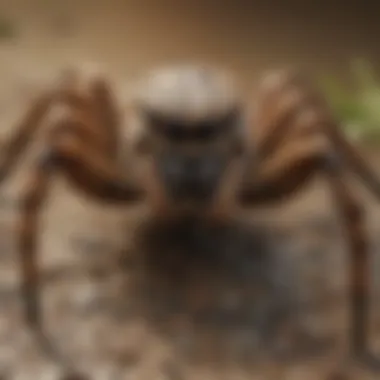
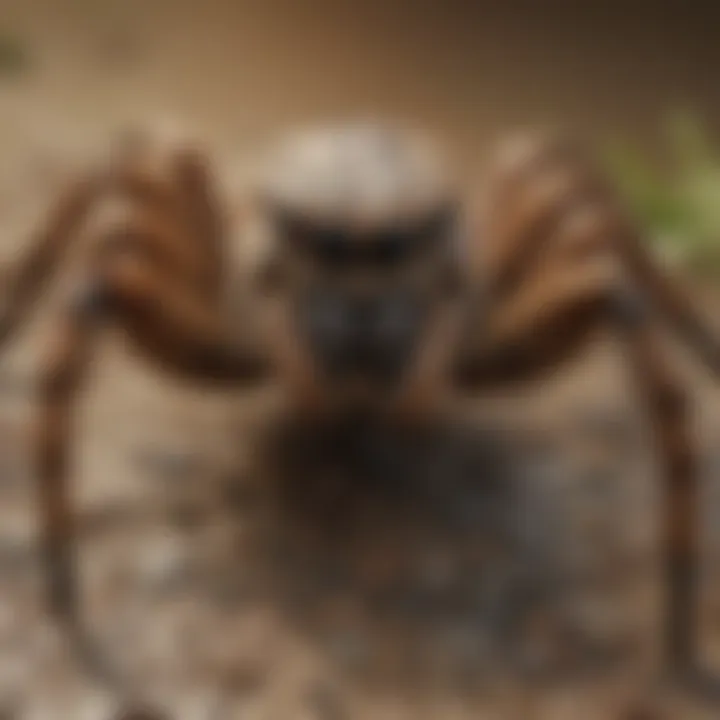
Intro
Wolf spiders play a crucial role in the ecosystems where they reside. Their predatory nature helps maintain the balance of insect populations, serving as both hunters and prey within the complex web of life. However, these spiders face numerous challenges that threaten their survival. Understanding these threats is vital not just for the conservation of wolf spiders, but also for the broader implications for biodiversity and pest management strategies.
Understanding the Pest
Identification
Wolf spiders belong to the family Lycosidae. They are recognized for their robust bodies and long legs. Typically, they vary in color from brown to gray. Some species may even exhibit distinct markings. These spiders can be found almost everywhere, from forests to your backyard. The ability to identify them is key.
Wolf spiders are usually medium to large in size. Adults can measure from 1 to 5 centimeters in length, with leg spans reaching up to 10 centimeters. Their eyes are another distinguishing feature; they have eight eyes arranged in three rows. This unique arrangement allows for better vision, aiding their hunting skills.
Life Cycle
Wolf spiders have a fascinating life cycle that influences their population dynamics. They undergo a simple metamorphosis, passing through three developmental stages: egg, juvenile, and adult. The mating season varies by region but usually occurs in spring.
After mating, females produce egg sacs that can contain hundreds of eggs. They carry these sacs attached to their spinnerets until the eggs hatch, further promoting survival rates for the young. The juvenile spiders will continue to grow, often facing various threats from the moment they emerge.
Pest Prevention Strategies
Environment Modification
Modifying the environment can significantly reduce the likelihood of wolf spiders invading human spaces. Proper landscaping is essential. Keeping gardens tidy, trimming overgrown plants, and removing debris can help. Eliminating potential hiding spots decreases their chances of establishing a presence.
Physical Barriers
Employing physical barriers can also be effective. Installing screens on windows and doors can limit their access to homes. Seal cracks and crevices around your property. By doing so, the risk of wolf spiders entering your living spaces is minimized.
Control Methods
Chemical Control
Chemical control methods often involve the use of insecticides. However, caution is necessary. Over-reliance on chemicals can be detrimental. It not only affects wolf spiders but can also harm beneficial insects and disrupt local ecosystems. It is advisable to consult pest management professionals who understand the local environment and its intricacies.
Biological Control
Biological control involves using natural predators to manage wolf spider populations. Birds and certain insects are known to feed on wolf spiders. Promoting an environment conducive to these natural predators can help maintain a balance. For example, planting native shrubs and flowers can attract birds that prey on these spiders.
By understanding the threats faced by wolf spiders and implementing informed pest management strategies, we contribute to the preservation of biodiversity.
This comprehensive approach combines awareness with actionable steps. Recognizing the threats that wolf spiders face is fundamental. It encourages responsible practices that benefit both the spiders and human habitats.
Preface to Wolf Spiders
Wolf spiders are an integral part of many ecosystems, functioning primarily as predators. Understanding these creatures is crucial, as they play a significant role in maintaining ecological balance. This section will provide a foundational knowledge about wolf spiders, exploring their definition and ecological importance.
Defining Wolf Spiders
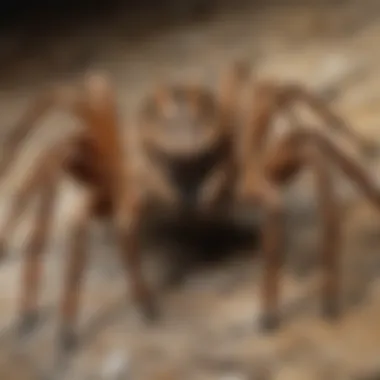
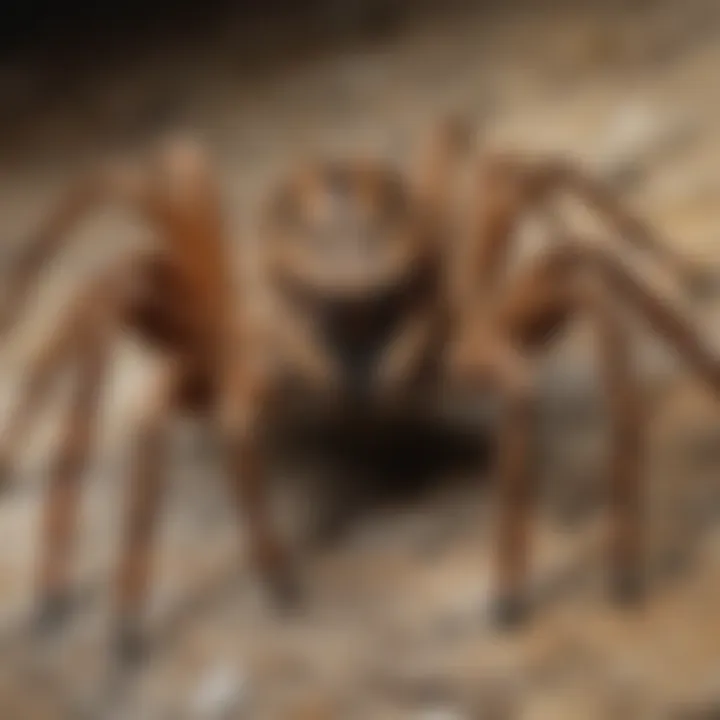
Wolf spiders belong to the family Lycosidae. These spiders are typically characterized by their robust bodies and long legs. They are known for their unique hunting methods, which do not rely on webs to catch prey. Instead, wolf spiders actively hunt down their victims, using their keen eyesight and swift movements. They are often found in various habitats, including forests, grasslands, and gardens. While they can vary in size, most species do not exceed two inches in length, making them a common sight in many environments.
Furthermore, wolf spiders exhibit a notable feature: they carry their egg sacs attached to their spinnerets. Upon hatching, the spiderlings ride on their mother’s back for some time. This behavior showcases a level of parental care not typically seen in many arachnids.
Ecological Role of Wolf Spiders
The ecological significance of wolf spiders cannot be overstated. They serve as both predators and prey within their ecosystems. Wolf spiders effectively control insect populations, including various pests that can damage crops and gardens. Their presence can help maintain a balance in the ecosystem, reducing the need for chemical pesticides.
The impact of wolf spiders extends beyond their role as predators. They also serve as a food source for various birds, reptiles, and other larger predatory animals. The interconnectedness of wolf spiders with other species emphasizes their importance in food webs and biodiversity.
In summary, by understanding wolf spiders, we can appreciate their contributions to environment and pest control. Their role in ecosystems highlights the need for informed approaches in managing their populations and preserving biodiversity.
Natural Predators of Wolf Spiders
Natural predators play a significant role in the survival dynamics of wolf spiders. They can affect both the population levels and the behavior of these spiders. Understanding the interaction between wolf spiders and their predators helps in comprehending the ecological balance in which these spiders exist. Several types of animals hunt wolf spiders, and each has a unique impact on them.
Common Predators
Birds
Birds are among the most prominent predators of wolf spiders. Avian species often hunt these spiders as part of their diet. Their ability to spot small movements and quick reflexes makes them effective predators. The plaguing presence of birds signifies a natural balance in ecosystems. Most birds tend to have excellent vision, allowing them to locate wolf spiders even when they are camouflaged. This characteristic is crucial for birds as it enhances their hunting efficiency. However, the presence of birds can also lead to a decline in the wolf spider population, which may disturb the food chain and ecological balance.
Lizards
Lizards also contribute to the predation of wolf spiders. They are skilled hunters, using stealth and speed to catch their prey. Lizards often inhabit environments similar to that of wolf spiders, making encounters commonplace. Their agility and ability to hunt effectively can significantly lower wolf spider numbers in specific habitats. This predation can have diverse consequences on the population dynamics of these spiders. Furthermore, the presence of lizards maintains a balance within the ecosystem, which is valuable for promoting biodiversity.
Other Insects
In addition to birds and lizards, other insects may prey upon wolf spiders. Predatory insects like wasps and some beetles can pose a threat to these spiders. Insects are numerous and can be found in various ecosystems, making their impact considerable. They may actively hunt wolf spiders or scavenge them when they are injured or vulnerable. However, while other insects can significantly affect wolf spider populations, their relationship tends to vary across different ecosystems. The impact of insects on wolf spiders demonstrates the complexity of the food web and ecological interactions.
Impact of Predation on Populations
Predation has a profound effect on wolf spider populations. The constant threat from natural predators can shape their behaviors, leading to adaptations like enhanced camouflage. Over time, these adaptations may influence their survival rates. Additionally, if the predator population increases, the consequences may escalate, potentially leading to a population crash of wolf spiders. Successful hunting strategies and predator-prey dynamics are crucial to sustaining healthy populations of wolf spiders and their natural predators. As such, understanding this balance is key to conservation efforts and pest management.
Environmental Changes Affecting Wolf Spiders
The survival of wolf spiders is heavily influenced by their environment. Various changes, primarily from human activities, can disrupt the delicate balance these creatures rely on. Understanding these changes is crucial, as they can lead to significant declines in wolf spider populations. Habitat destruction and climate change stand out as major threats. Knowing how these factors interact can help in devising strategies to protect these spiders and maintain biodiversity within ecosystems.
Habitat Destruction
Habitat destruction occurs when natural environments are altered or eliminated, impacting the species that rely on them. For wolf spiders, this often means losing essential hunting grounds and shelter. Urban development, agriculture, and deforestation are key contributors to this destruction. As natural habitats diminish, wolf spiders face greater challenges in finding food and safe breeding areas. This loss of habitat can result in decreased population numbers, further disrupting ecological balance.
Climate Change Impacts
Temperature Variations
Temperature variations are a direct consequence of climate change. These fluctuations can disrupt the lifecycle of wolf spiders. Higher temperatures may accelerate their metabolic rates, which could lead to premature death. Wolf spiders are adapted to specific temperature ranges, so unexpected changes can push them outside their comfort zone. Importantly, an increase in temperature can also alter prey availability, as other insects may respond differently to warming. This can create a domino effect that threatens not only wolf spiders but the broader food web.
Humidity Levels
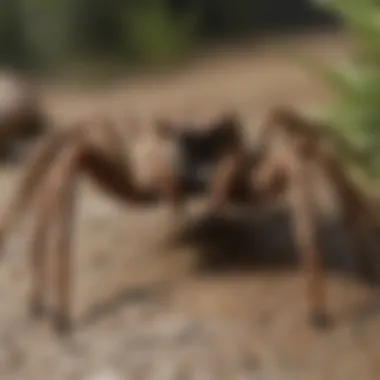
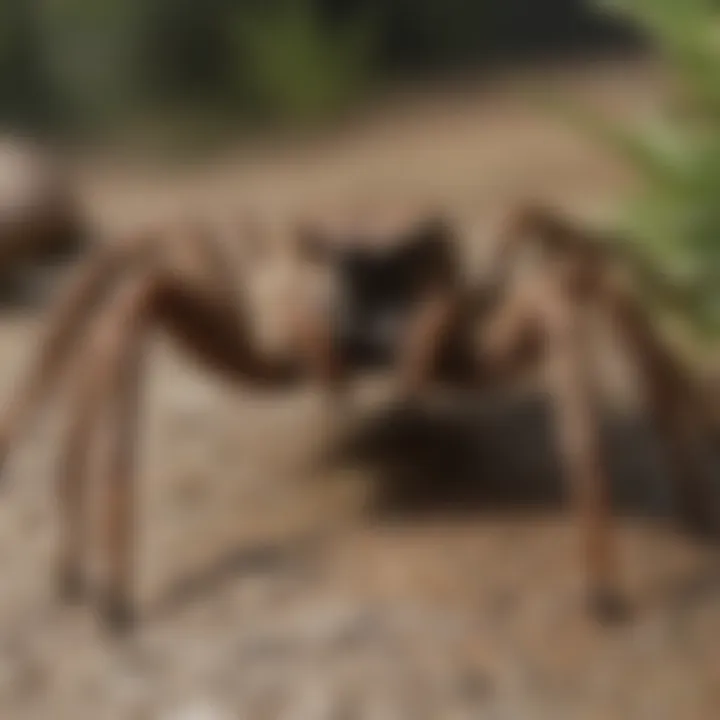
Humidity levels are essential for the survival of wolf spiders. These arachnids prefer environments that provide adequate moisture. Changes in humidity due to climate change can hinder their ability to reproduce effectively. Too much dryness can lead to dehydration and increased mortality rates. Additionally, fluctuations in humidity can affect the availability of their prey, such as insects, thus further impacting their survival. Establishing a stable humidity level is critical for the well-being of wolf spiders and their role in the ecosystem.
"The interaction between climate fluctuations and habitat changes shows us how intertwined the survival of wolf spiders is with our environment."
Understanding environmental changes gives insights into how best to protect wolf spiders. Mitigating these impacts requires broader conservation efforts to preserve their habitats and create sustainable ecosystems.
Human Influence on Wolf Spider Mortality
Human actions significantly impact the survival and well-being of wolf spiders. These spiders are often overlooked in pest management discussions, yet their ecological roles are critical. Understanding how human influence affects their populations can promote balance in ecosystems and improve pest management strategies. The increasing urbanization, use of pesticides, and habitat destruction are just a few aspects that warrant examination.
Pesticides and Their Effects
The use of pesticides is a common practice in pest control. While it aims to eliminate unwanted insects, it inadvertently affects other species, including wolf spiders. Pesticides such as glyphosate and imidacloprid have been shown to be harmful to non-target organisms. Wolf spiders, being generalist predators, might consume insects that have been exposed to these chemicals.
- Bioaccumulation: When wolf spiders eat contaminated prey, harmful substances accumulate in their bodies. This can lead to health problems or even mortality.
- Direct Toxicity: Pesticides can cause direct harm when wolf spiders are exposed during spraying. This can quickly reduce their numbers in affected areas.
There is also a growing concern about the impact of neonicotinoids, which are neurotoxic to insects. The implications for wolf spiders can be significant because they rely on a healthy insect population for their survival.
Urbanization and Habitat Fragmentation
Urbanization is another key factor influencing the mortality of wolf spiders. As cities expand, natural habitats are often destroyed or fragmented, leaving fewer places for wolf spiders to thrive.
- Loss of Habitat: The removal of native flora not only reduces the prey available to wolf spiders but also diminishes shelter options, putting these predators at risk.
- Fragmentation: Isolated habitats can hinder the movement of wolf spiders, making it difficult for them to find mates or food. This can lead to decreased population resilience.
Urban areas often exhibit increased human activity, such as higher foot traffic and pollution. These factors can stress wolf spider populations even further. Assessing the relationship between urbanization and wildlife is crucial for understanding the long-term viability of these important predators in changing environments.
"Human influence can have unintended consequences on the ecosystem, raising serious questions about how to manage our surroundings responsibly."
In summary, the impact of human activity on wolf spider mortality requires attention and understanding. Increased awareness can guide better pest management practices, ensuring the preservation of biodiversity.
Disease and Parasites in Wolf Spiders
The topic of diseases and parasites affecting wolf spiders is crucial in understanding their overall survival and population dynamics. Wolf spiders may seem resilient, but they are vulnerable to various pathogens and parasitic organisms. These factors can significantly impact their health, reproductive success, and longevity. By examining these elements, we can gain insights into how diseases and parasites contribute to declines in wolf spider populations and what that means for ecosystems.
Common Diseases
Wolf spiders can be affected by several infectious diseases. Some of these include viral, bacterial, and fungal infections. Each type poses different risks to the health of these spiders.
- Viruses: Some studies indicate that wolf spiders may harbor certain viruses that can lead to severe outcomes. Viral infections can compromise their immune systems, making them more susceptible to other threats.
- Bacteria: Bacterial infections can arise from wounds or environmental conditions. For instance, a spider with a physical injury from predation or human activity may become infected, resulting in high mortality rates.
- Fungal Infections: Fungi can also target wolf spiders. Certain fungi can infect the spider’s body, leading to disease and ultimately, death. These infections can spread quickly in dense populations, which highlights the importance of monitoring for outbreaks.
Maintaining a healthy habitat can reduce the likelihood of disease outbreaks. Ensuring that there are adequate food sources can foster stronger, more resilient spider populations.
Parasites That Target Wolf Spiders
Parasites exert significant pressure on wolf spider populations. Knowing these parasite-host relationships is essential for understanding how they affect both individual spiders and the broader ecosystem.
- Parasitic Wasps: Some wasps lay their eggs inside wolf spiders. The wasp larvae consume the spider from the inside. This not only leads to the death of the spider but can also affect the population dynamics within their habitat.
- Nematodes: Parasites in the form of nematodes can invade wolf spiders and affect their reproductive abilities. Such infections can lead to reduced population numbers over time.
- Fungal Parasites: Similar to the previously mentioned fungal infections, some fungi can parasitize spiders specifically. These parasites can manipulate the host’s behavior, affecting their movements and survival.
Research indicates that interactions between parasites and their hosts can alter the ecological balance, influencing predator-prey dynamics.


Behavioral Adaptations to Threats
Wolf spiders have developed unique behavioral adaptations that help them cope with various threats in their environment. Understanding these adaptations is essential for comprehending how these creatures survive in a world filled with natural predators, environmental changes, and human impacts. Behavioral adaptations are crucial as they allow wolf spiders to enhance their chances of survival.
Camouflage and Hunting Techniques
Camouflage plays a significant role in the survival of wolf spiders. They possess a coloration that blends well with their surroundings, from leaf litter to the ground surface. This ability to remain hidden makes it challenging for predators to spot them. Additionally, wolf spiders are primarily visual hunters, relying on acute vision to detect movement rather than smell. They often employ a strategy of stillness, sitting quietly to avoid detection. When prey approaches, they strike quickly and effectively, showcasing their agility and speed.
By using the environment to their advantage, wolf spiders can reduce their risk of being preyed upon. This adaptive behavior also allows them to conserve energy, as they can remain inactive for substantial periods, waiting for prey to come within range. In this sense, camouflage does not only serve to hide from predators but also facilitates effective hunting strategies, thus ensuring the wolf spider's survival in changing environments.
Migration and Dispersal Strategies
Migration and dispersal are critical adaptations that enable wolf spiders to respond to threats in their habitat. In situations where environmental conditions become unfavorable—such as habitat destruction or changes in climate—wolf spiders may leave their current location in search of more suitable areas. This ability to migrate can help them avoid predators and find new sources of food, thereby enhancing their survival prospects.
Dispersal strategies may involve both short and long-distance movements. Wolf spiders can use various methods to travel, including walking or using wind currents to carry them across distances. Additionally, females sometimes disperse their egg sacs by dropping them in safe locations, ensuring that the next generation has a higher chance of survival. This behavior is especially crucial as it allows for population recovery in areas impacted by threats like urbanization and habitat fragmentation.
In summary, the behaviors exhibited by wolf spiders in terms of camouflage, hunting, migration, and dispersal reflect a complex interaction between ecological pressures and survival tactics. Understanding these adaptations not only informs us about their role in ecosystems but also highlights the importance of conserving their habitats for future generations.
Research Insights on Wolf Spider Mortality
The study of wolf spider mortality is crucial for several reasons. First, it provides an understanding of how various threats influence their populations and behaviors. This insight can inform effective pest management strategies that consider not only the ecological role of wolf spiders but also their interactions with humans and the environment. By analyzing the factors that affect their survival, researchers can identify key areas for conservation efforts.
Moreover, research in this area emphasizes the importance of maintaining biodiversity. Wolf spiders are significant predators, and their decline could lead to imbalances in local ecosystems. Therefore, insights derived from recent studies can guide homeowners and land managers in making informed decisions about pest control that do not undermine ecological stability.
Recent Studies and Findings
Recent studies have shed light on the various mortality causes for wolf spiders. One notable research effort conducted surveys in urban and rural settings, examining the effects of habitat fragmentation and pesticide use. The findings indicated that urban areas had lower wolf spider populations due, in part, to habitat loss and increased exposure to harmful chemicals.
Other research has focused on climate change impacts on wolf spider physiology and behavior. Results show that rising temperatures and shifting humidity levels can alter their hunting patterns and reproduction success. Studies have revealed that some species are more susceptible to these changes than others, revealing critical information for species conservation efforts.
Conservation Efforts
In response to the threats faced by wolf spiders, several conservation initiatives have started to emerge. These efforts focus on habitat preservation and restoration, which are pivotal for maintaining their natural ecosystems. Local communities are encouraged to participate in planting native vegetation which can provide shelter and food sources for these spiders.
Another significant effort involves educating landowners about the impacts of pesticides. Many organizations promote integrated pest management practices that reduce the reliance on chemical treatments.
"Understanding and mitigating the factors leading to wolf spider mortality is essential for ecological health and pest control strategies." This awareness can lead to better management practices that protect not only wolf spiders but also the entire ecosystem they inhabit.
In summary, ongoing research into wolf spider mortality not only highlights the threats they face but also aids in developing effective conservation strategies. By prioritizing these insights, we can foster a balanced relationship between human habitats and these essential predators.
Culmination: Balancing Ecological Dynamics and Pest Control
Wolf spiders hold an essential role in maintaining ecological balance. The way these creatures interact with their environment showcases the intricate dynamics of predator and prey relationships. Recognizing the importance of these relationships is crucial for understanding their survival prospects amidst various threats. The interplay between biodiversity and pest control is more than just a matter of eliminating unwanted species. It asks us to consider the long-term implications for ecological health and community dynamics.
Importance of Biodiversity
Biodiversity is not merely a term thrown around in conservation discussions; it is the backbone of healthy ecosystems. Wolf spiders contribute significantly to controlling insect populations, which can help mitigate pest problems for humans. When biodiversity diminishes, ecological roles become compromised. This can lead to larger pest outbreaks, which may drive humans to use chemicals that could harm beneficial species, including wolf spiders themselves.
Maintaining a healthy population of wolf spiders ensures stability within their habitats. They help control the numbers of various insects. With fewer spiders, residents might face an infestation of pests that can invade homes and gardens.
"Diverse environments are more resilient and facilitate easier adaptation to changes."
This resilience is crucial as climate change continues to alter habitats. From local gardens to wider ecosystems, a balanced approach recognizes that every species plays a part. Thus, it is vital to sustain biodiversity to foster healthy environments.
Future Outlook for Wolf Spiders
The future of wolf spiders depends on multiple factors such as habitat conservation and public perception. As urbanization increases, habitats shrink, putting additional pressure on these spiders. Education plays a significant role here. By informing the public about the ecological benefits of wolf spiders, we can foster coexistence rather than hostility.
Research continues to evolve around effective pest management strategies. Innovative methods that minimize harm to non-target species like wolf spiders are being developed daily. Integration of ecological data with pest control measures can provide a more sustainable approach that respects all forms of life. The future may see a broader acceptance of biological control, where species like wolf spiders are utilized to naturally manage pests instead of relying solely on chemical solutions.





